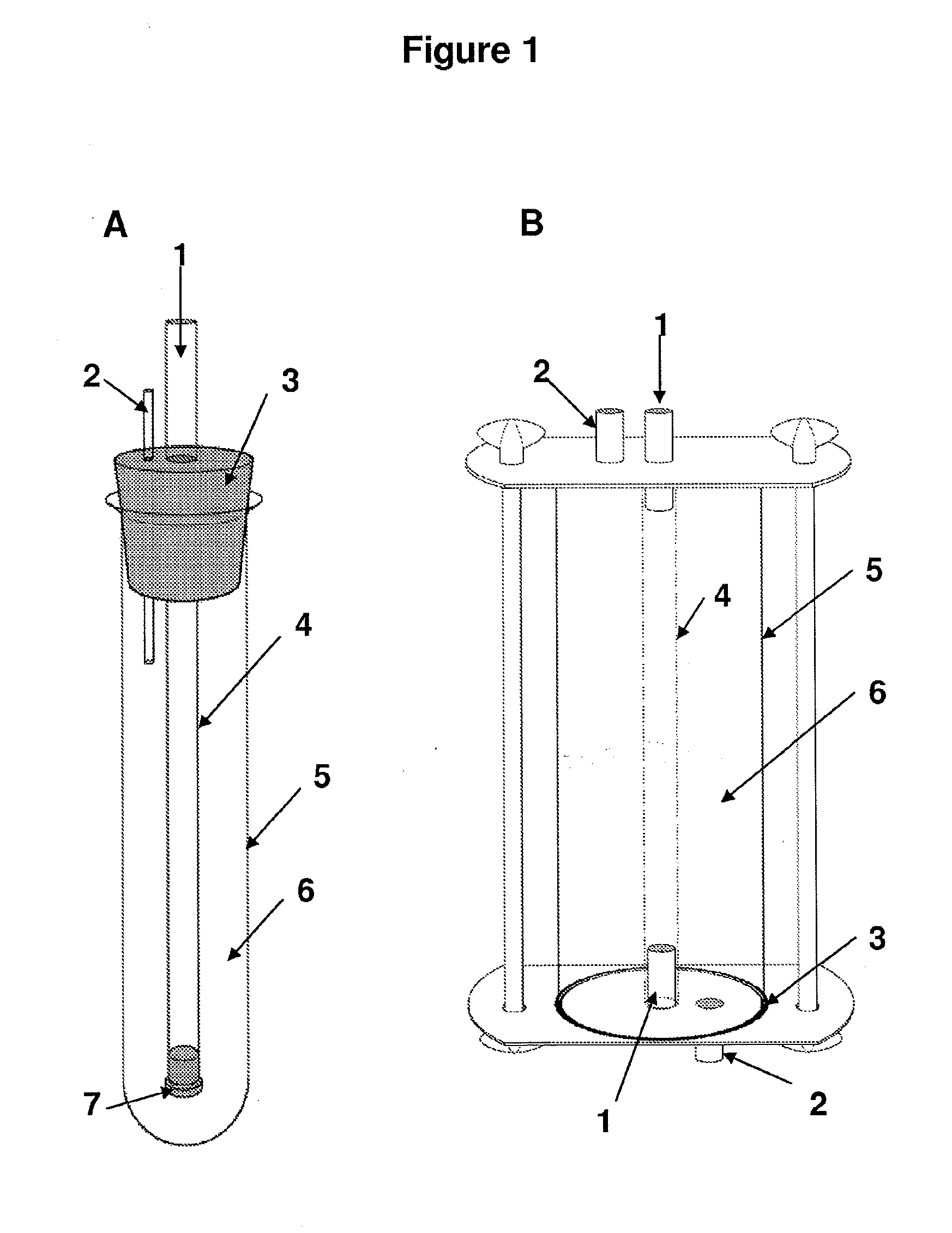Preparation of hollow cellulose vessels
a hollow cellulose and cellulose technology, applied in the field of hollow cellulose vessels, can solve the problems of less suited replacement of larger blood vessels for microorganism cellulose with a horizontal layered structure, and achieve the effects of good bio-compatibility and suitability, good mechanical properties, and good compatibility with a living body
- Summary
- Abstract
- Description
- Claims
- Application Information
AI Technical Summary
Benefits of technology
Problems solved by technology
Method used
Image
Examples
example 1
[0070]Fermentation
[0071]The fermentation of the tubes was carried out submerged in glass tubes of 70 ml by using a silicone tube (4×0.5 mm in diameter; 50 shores; Lebo production AB, Sweden) as oxygen permeable material. Gas mixtures with different concentrations of oxygen i.e. 21% (air), 35%, 50% and 100% at atmospheric pressure were provided into the oxygen-permeable. A complex media (CSL) (Matsuoka et al. Biosci., Biotechnol., Biochem. 60 (1996) 575-579) and a slightly modified defined media described by Son et al (Bioresource Technology 86 (2003) 215-219) were used as fermentation media. The Glucose and fructose consumption and pH were measured using standard enzymatic kit (R-Biopharm, Food Diagnostics AB Sweden). The strain used for the biosynthesis was Acetobacter xylinum subsp.sucrofermentas BPR2001, tradenmbr: 1700178™. The strain was purchased from the American Type Culture Collection. Six Cellulose forming colonies were cultivated for two days in Rough flask yielding a cel...
example 2
[0081]Mechanical Properties
[0082]Burst Pressure Measurement
[0083]By applying a pressure through a water column, a flow with an increasing pressure was established. All tubes were tested on three locations upper, middle and lower part. The vessels were exposed to elevated pressure 1 bar / 10 s. The pressure when burst occurred was registered.
[0084]Texture and Penetration Resistance.
[0085]The test was performed on a TA-XT2i Texture analyser (Stable Micro Systems, Surrey, England). The tube sample was cut open with a pair of scissors, in one cutting motion. The sample was placed over a hole in the sample holder and anchored tightly to the holder. A probe with a diameter of 2 mm was used and a load cell of 5 kg. Penetration force was measured at a speed of 0.1 mm / sec. The peak force was then recorded and compared with different materials. Tests were performed on tubes cultured with 50% oxygen and 100% oxygen; they had peak values of 1500N and 3800N respectively. Penetration resistance can...
example 3
[0089]Cell Seeding
[0090]Endothelial cells (HSVECs) were isolated from healthy parts of human saphenous veins. Veins were either spare parts from coronary bypass operations or taken from patients having surgery for varicose vein. HSVECs were isolated using an enzymatic technique. The cells were seeded into the luminal side of the BC-tube and cultured under static conditions for 7 days humidified atmosphere of 95% air / 5% CO2 and a temperature of 37° C. Cells were fixed in 3.7% formaldehyde and the nuclei were counter stained with 4′,6-diamidino-2-phenylindole,dihydrochloride, DAPI (Sigma-Aldrich).
[0091]Cultivation of endothelial cells onto the lumen of the bacterial cellulose tubes shows that we get a confluent layer of endothelial cells after 7 days.
PUM
| Property | Measurement | Unit |
|---|---|---|
| glass transition temperature | aaaaa | aaaaa |
| glass transition temperature | aaaaa | aaaaa |
| glass transition temperature | aaaaa | aaaaa |
Abstract
Description
Claims
Application Information
 Login to View More
Login to View More - R&D
- Intellectual Property
- Life Sciences
- Materials
- Tech Scout
- Unparalleled Data Quality
- Higher Quality Content
- 60% Fewer Hallucinations
Browse by: Latest US Patents, China's latest patents, Technical Efficacy Thesaurus, Application Domain, Technology Topic, Popular Technical Reports.
© 2025 PatSnap. All rights reserved.Legal|Privacy policy|Modern Slavery Act Transparency Statement|Sitemap|About US| Contact US: help@patsnap.com



